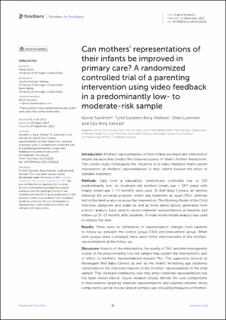| dc.contributor.author | Sandnes, Kjersti | |
| dc.contributor.author | Berg-Nielsen, Turid Suzanne | |
| dc.contributor.author | Lydersen, Stian | |
| dc.contributor.author | Berg Kårstad, Silja | |
| dc.date.accessioned | 2024-01-19T09:10:42Z | |
| dc.date.available | 2024-01-19T09:10:42Z | |
| dc.date.created | 2023-09-26T07:55:09Z | |
| dc.date.issued | 2023 | |
| dc.identifier.citation | Frontiers in Psychiatry. 2023, 14 . | en_US |
| dc.identifier.issn | 1664-0640 | |
| dc.identifier.uri | https://hdl.handle.net/11250/3112713 | |
| dc.description.abstract | Introduction: Mothers’ representations of their infants are important intervention targets because they predict the observed quality of infant–mother interactions. The current study investigated the influence of a video-feedback infant-parent intervention on mothers’ representations of their infants beyond the effect of standard treatment.
Methods: Data from a naturalistic, randomized controlled trial of 152 predominantly low- to moderate-risk mothers (mean age = 29.7 years) with infants (mean age = 7.3 months) were used. At Well Baby Centers, all families followed the universal program, which was treatment as usual (TAU), whereas half of the families also received the intervention. The Working Model of the Child Interview categories and scales as well as three latent factors generated from a factor analysis were used to assess maternal representations at baseline and follow-up (9–13 months after baseline). A linear mixed model analysis was used to analyze the data.
Results: There were no differences in representation changes from baseline to follow-up between the control group (TAU) and intervention group. When both groups were combined, there were minor improvements in the mothers’ representations at the follow-up.
Discussion: Aspects of the intervention, the quality of TAU, and the homogeneity scores of the predominantly low-risk sample may explain the intervention’s lack of effect on mothers’ representations beyond TAU. The supportive services at Norwegian Well Baby Centers as well as the infants’ increasing age putatively contributed to the improved features of the mothers’ representations in the total sample. That standard community care may affect maternal representations has not been shown before. Future research should identify the core components in interventions targeting maternal representations and examine whether those components can be incorporated in primary care. Including measures of mothers’ reflective functioning could broaden our knowledge of representations and their changeability. | en_US |
| dc.language.iso | eng | en_US |
| dc.publisher | Frontiers Media | en_US |
| dc.rights | Navngivelse 4.0 Internasjonal | * |
| dc.rights.uri | http://creativecommons.org/licenses/by/4.0/deed.no | * |
| dc.title | Can mothers' representations of their infants be improved in primary care? A randomized controlled trial of a parenting intervention using video feedback in a predominantly low- to moderate- risk sample | en_US |
| dc.title.alternative | Can mothers' representations of their infants be improved in primary care? A randomized controlled trial of a parenting intervention using video feedback in a predominantly low- to moderate- risk sample | en_US |
| dc.type | Peer reviewed | en_US |
| dc.type | Journal article | en_US |
| dc.description.version | publishedVersion | en_US |
| dc.source.pagenumber | 16 | en_US |
| dc.source.volume | 14 | en_US |
| dc.source.journal | Frontiers in Psychiatry | en_US |
| dc.identifier.doi | https://doi.org/10.3389/fpsyt.2023.1232816 | |
| dc.identifier.cristin | 2178775 | |
| cristin.ispublished | true | |
| cristin.fulltext | original | |
| cristin.qualitycode | 1 | |

